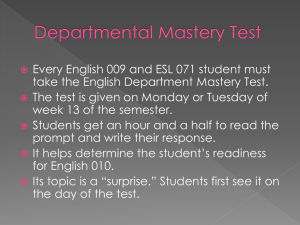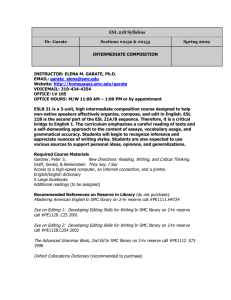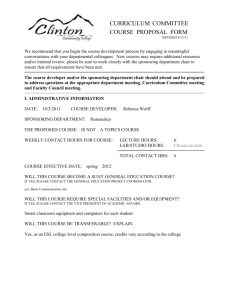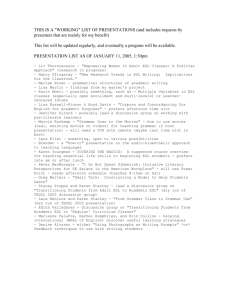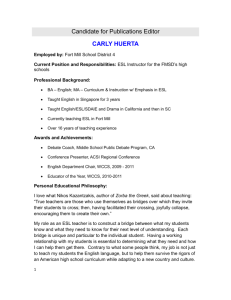esl 21a: intermediate paragraph/essay composition and grammar
advertisement
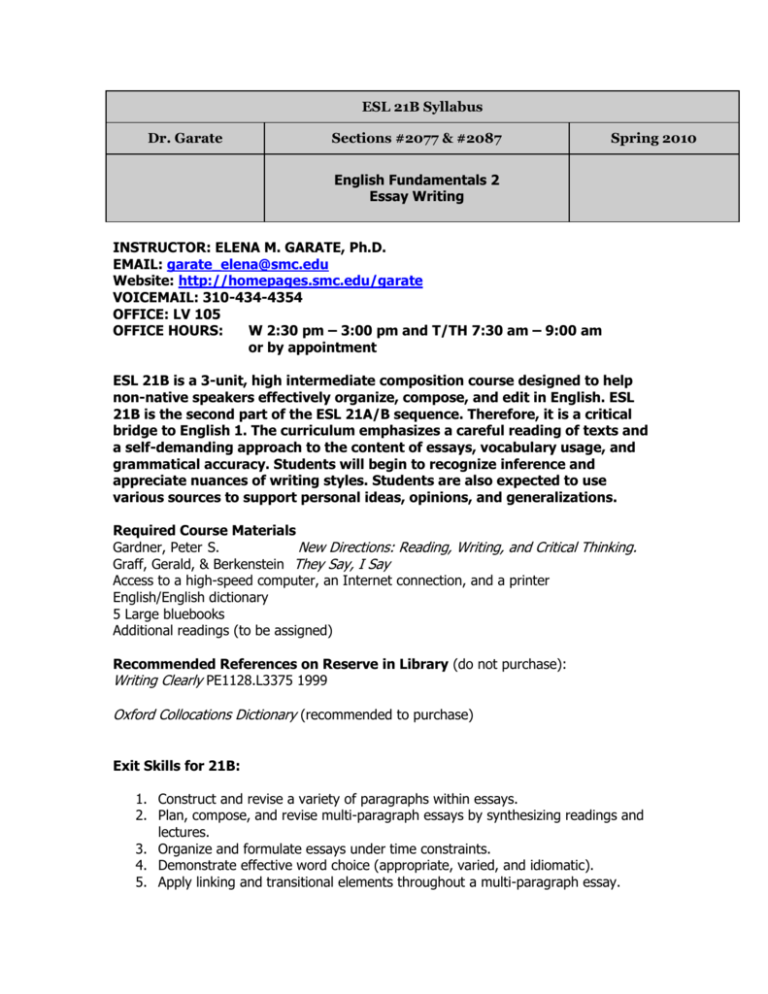
ESL 21B Syllabus Dr. Garate Sections #2077 & #2087 Spring 2010 English Fundamentals 2 Essay Writing INSTRUCTOR: ELENA M. GARATE, Ph.D. EMAIL: garate_elena@smc.edu Website: http://homepages.smc.edu/garate VOICEMAIL: 310-434-4354 OFFICE: LV 105 OFFICE HOURS: W 2:30 pm – 3:00 pm and T/TH 7:30 am – 9:00 am or by appointment ESL 21B is a 3-unit, high intermediate composition course designed to help non-native speakers effectively organize, compose, and edit in English. ESL 21B is the second part of the ESL 21A/B sequence. Therefore, it is a critical bridge to English 1. The curriculum emphasizes a careful reading of texts and a self-demanding approach to the content of essays, vocabulary usage, and grammatical accuracy. Students will begin to recognize inference and appreciate nuances of writing styles. Students are also expected to use various sources to support personal ideas, opinions, and generalizations. Required Course Materials Gardner, Peter S. New Directions: Reading, Writing, and Critical Thinking. Graff, Gerald, & Berkenstein They Say, I Say Access to a high-speed computer, an Internet connection, and a printer English/English dictionary 5 Large bluebooks Additional readings (to be assigned) Recommended References on Reserve in Library (do not purchase): Writing Clearly PE1128.L3375 1999 Oxford Collocations Dictionary (recommended to purchase) Exit Skills for 21B: 1. Construct and revise a variety of paragraphs within essays. 2. Plan, compose, and revise multi-paragraph essays by synthesizing readings and lectures. 3. Organize and formulate essays under time constraints. 4. Demonstrate effective word choice (appropriate, varied, and idiomatic). 5. Apply linking and transitional elements throughout a multi-paragraph essay. ESL 21B #2077 & 2087 6. Inventory sections of a text before reading. 7. Differentiate main ideas and details. 8. Analyze a text for the evidence of the writer’s audience, purpose, bias, tone, and register. 9. Recognize connotative and denotative meanings of academic vocabulary. 10. Identify inferential and literal information. 11. Annotate texts for specific purposes. 12. Construct the following in speaking/writing: all verb tenses/forms; all independent and dependent clause types; articles; word forms. 13. Interpret information from readings and audio/video feeds in pairs or small groups to select and evaluate ideas for writing. 14. Propose and illustrate opinions to organize and participate in group or individual presentations. Entry Skills for English 1: 1. Write sentences of varying syntactical structure, generally free of grammatical, spelling and syntactical errors. 2. Read, draw inferential and literal information from, and evaluate academic and popular prose, in order to use one or two readings to support a focused essay. 3. Write effective thesis statements. 4. Write strong topic sentences and situate them effectively within body paragraphs. 5. Write effective introductory, body, and concluding paragraphs in essays. 6. Write coherent and cohesive expository essays, or at least five paragraphs that are developed by definition, description, exemplification, cause and effect, classification, comparison/contrast, analysis or argumentation, as required by the writing situation. 7. Use linking and transitional elements within sentences, between sentences, and between paragraphs. 8. Compose papers efficiently using various pre-writing, revising, and editing strategies. 9. Understand terminology related to critical thinking – discuss, explain, analyze, compare and contrast, define, summarize, argue, narrate – in order to proceed appropriately in test-taking situations. 10. Produce in a sixty-minute period, a 350 to 500-word essay, divided into acceptable paragraphs, that focuses on a given topic. 11. Recognize the distinction between paraphrasing, summarizing, and quoting secondary sources. 12. Differentiate main ideas and details consistently in expository writing. 13. Begin to identify and understand the importance of audience, purpose, and tone, and appropriate academic style. 14. Begin to recognize that words have both connotative and denotative meanings. 2 ESL 21B #2077 & 2087 Classroom Requirements Protocols: No food or drinks in the classroom. All pagers, cell phones and other electronic devices must be turned off during class. Attendance: Regular attendance is crucial. Students who miss more than 6 hours of class may be dropped. If you know in advance that you will be absent, contact me by email. In addition, please arrange for a classmate to pick up any material handed out during the session. Lateness: Students who consistently arrive late for class or leave early may be dropped. Two tardies equal one absence. Disruption of the class by late arrivals is unacceptable. Drops: Students are responsible for dropping the course. Check the drop deadlines. Failure to drop may result in an “F.” Writing: Graded writing assignments will be written and revised in and outside of class. Final drafts of all essays, paragraphs, and summaries must be word-processed. Put your last name, first name, ESL 21B, the Section # and the date in the upper right-hand corner of 8 ½ by 11 lined paper. No late papers will be accepted without a valid reason. Journals: Dated, titled, and numbered entries will be written both in and outside of class. Most will be posted through eCompanion on Document Sharing. Quizzes: Occasional quizzes will cover vocabulary, content, grammar, mechanics, terminology and editing skills. Quizzes must be made up before the next class meeting. Exams: There will be two major writing exams during the semester: the Common Essay exam and the final. The common essay exam will be given the 12th week of the semester and the final essay will be given on the day of the Final Exam. It is not possible to pass the class without taking the final. Group Work: Students are expected to participate in study groups in and outside of class. It is advisable to read and study with your classmates outside of class. Communication: You may communicate with me either through voice mail or email. I will try to reply as soon as possible. Write your full name and ESL 21B when you send me an email. I recommend that you get the phone number or email of at least two classmates to learn about class activities and discussions if you miss class. Homework: Homework is posted on eCompanion. Students are responsible for accessing the assignments on line and completing them, even if they are absent. 3 ESL 21B #2077 & 2087 Online Support Students enrolled in these classes should consult eCompanion through the SMC Student Self-Service site: https://isismc01.smc.edu/pls/smcweb/f?p=108:102:4564434239142244 for course information, posted messages, lectures, and their current grades. You must be enrolled in the class in order to access eCompanion. Students will be required to print out course materials that are posted on eCompanion. Grading: (Note: ESL 21B may be taken for credit/no credit. This decision, however, must be made at an early point in the semester. See your counselor for further credit/ transfer guidance.) In-class essays Common Essay In-Class Writing Revisions Final Exam Quizzes and Summaries Homework and Journals SMC Grading Scale 100 – 90% 89 – 80% 79 – 70% 69 – 60% Below 59% 20% 10% 15% 10% 20% 20% 5% A (English I recommended) B (English I recommended) C (ESL 25 recommended) D (Repeat ESL 21B) F (Repeat ESL 21B) Support Courses: ESL 14A Pronunciation and Spelling ESL 14B Pronunciation ESL 15 Conversation and Culture ESL 20A/B Advanced Grammar ESL 23 Advanced Reading ESL 28 Academic Vocabulary Tutoring: Free tutoring is available in the ESL Center. You must sign up online (http://homepage.smc.edu/ESL). Please note that tutors will not revise your work for you. However, they will help you work on your specific language issues. Please Note: The syllabus may be changed at any time during the semester at the discretion of the instructor. Supplementary readings and/or additional short texts will be assigned. Updated: 02-03-10 4 ESL 21B #2077 & 2087 Santa Monica College Code of Academic Conduct Santa Monica College does not tolerate academic dishonesty. Definition and Examples of Academic Dishonesty: SMC defines academic dishonesty as the act of or assistance in deceiving in any academic exercise. This includes: Copying or allowing another student to copy from one’s paper or answer sheet during a quiz or an examination. Giving and/or taking information during an examination by any means Representing the words, ideas or work of another as one’s own in any academic exercise (plagiarism), including the use of commercial term paper companies. Responsibility of SMC Students: To conduct him/herself in a manner which encourages learning and prohibits academic dishonesty. To act with fairness towards other students in the classroom. Consequences for Infractions of Academic Dishonesty: Given an alleged violation of academic honesty, any or all of the following actions may be imposed: The instructor may assign a failing grade to the examination or assignment in which the alleged cheating or plagiarism occurred. The instructor may dismiss the student from the class or activity for the present and/or following class session. What does this mean? 1. Do not copy someone else’s paragraph, quiz, or exam. 2. Do not allow someone to copy your paragraph, quiz, or exam. 3. Do not ask someone else for answers when writing a paragraph or during a quiz or exam. 4. Do not give someone answers when writing a paragraph or during a quiz or exam. 5. Do not present someone else’s work, or that from a textbook or article, as your own. 6. Do not pretend that work done outside of class was done in class. 5

